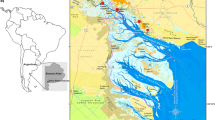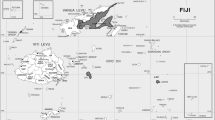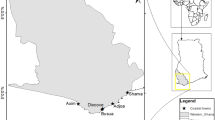Abstract
Some recent scholarship has focused on integrating local and/or traditional knowledge with conventional scientific information in fisheries management to improve the factual foundation of and strengthen support for management decisions. This article compares a sequence of historical and contemporary scientific texts and maps about the migrations and stock structure of cod in the Northern Gulf of St. Lawrence with texts and maps generated by the authors through the collection, aggregation and interpretation of commercial fish harvesters’ ecological knowledge. We find that the relationship between fisheries science and harvesters’ ecological knowledge is dynamic and has changed over time, and that both are ‘situated’ socially and ecologically. Overall, each paints an incomplete picture of cod movements and stock structure but the knowledge of harvesters provides a valuable complement to scientific information, particularly at the local scale, and has the potential to contribute to the identification of local cod stocks that are new to science and management. We end by considering how this case study informs the larger discussion about the challenges and potential benefits of the so-called integration project to bring together science and the ecological knowledge of fish harvesters.






Similar content being viewed by others
Notes
Our case study draws on research conducted during the 5-year Coasts Under Stress (CUS) Research Project.
Aletta Biersack (1999, p. 11), points to a growing resistance to the kinds of reductionism inherent in views of culture that are either materialist (culture as defined by nature) or idealist (culture as sui generis) and to a ‘growing insistence’ on a new kind of synthesis. In this article we argue that knowledge, like (or as) culture, is socially and ecologically mediated.
Some of the terms utilized in this article are used ambiguously and in overlapping ways by fishers and scientists. For the purpose of this paper, we define the following terms this way: A stock refers to fish found at any time of the year in a particular group of sub-divisions, such as 2J3KL or 3Pn4RS. A local stock refers to fish found at any time of the year in a defined geographic area, at a spatial scale smaller than these NAFO sub-division groupings. A subpopulation refers to fish that interbreed based on a fairly equal probability of encounter per fish, due to seasonal movement of those fish to a location where spawning occurs. A population refers to fish capable of interbreeding through some probability of encounter well below that in a subpopulation, due to geographic or temporal isolation of breeding activity. A stock component is a convenient term that recognizes that a stock defined by geographic boundaries (e.g. NAFO sub-divisions) will be composed of populations or subpopulations that generally do not interbreed. Finally the Northern Gulf stock and Northern Cod refer to fish of a single species (Gadus morhua) located in specified but different groups of NAFO sub-divisions (3Pn4RS and 2J3KL respectively) and consisting of several populations, all capable of producing reproductively capable offspring, and all of which are reproductively isolated (do not breed) from other similarly defined species (e.g. Gadus ogac).
This quota is divided into a number of categories based on vessel size, gear type and provenance. Quota is also assigned at different periods during the year (July, September and October) and allocated by area. See http://www.dfo-mpo.gc.ca/communic/statistics/commercial/quota_reports/2007/cod_e.htm for more detail.
Given the context of substantial overfishing of the Northern Gulf stocks and related changes in abundance and age-class structure of these cod stocks we draw to a limited extent on the scientific research suggesting migratory behaviour is age and density dependent (Thompson 1943; Templeman 1979; Sinclair et al. 1991; Lawson and Rose 2000; Rose and Kulka 1999). We do not, however, explore changes in tagging technologies over time as a process mediated by social (technological development and research) and ecological factors (retention rate linked to fish behaviour/biology). Nor do we explore in any depth the social and ecological factors mediating tag returns in mark-recapture studies, (Cadigan and Brattey 2006).
Our limited sample of relevant scientific publications is also partly driven by space constraints. Robichaud and Rose (2004) state that there are more than 500 scientific publications involving tagging data that describe the movement of cod in the North Atlantic (though only a fraction of these would pertain specifically to our study area).
In a separate, much larger scale study, Robichaud and Rose (2004) reviewed results from a century of tagging experiments on 174 Atlantic cod groups. Based on this review, they identified four migratory behaviours, classifying 41% of cod tag returns as indicating “sedentary” behaviour; 18% as “accurate homer” behaviour; 20% as “inaccurate homer” behaviour; and 20% as indicating “disperser” behaviour, i.e., movements that cover large areas without recognizable return movements. Their results also indicated that coastal cod (in contrast to offshore cod) are particularly likely to be sedentary, and that sedentary cod stocks tend to be associated with lower levels of historical maximum biomass.
In this case the authors use ‘access’ in the sense that these harvesters would be able to access (harvest) these fish near their own home ports.
Of course, this does not include the many paper and digital charts that fish harvesters routinely use in the course of fishing. While not utilized in our study, we suggest that these represent an area of potential research.
Copies of the audio cassettes and the original maps (where authorized by the respondents and with identifying information removed) were deposited in the Folklore Archive at Memorial University as both a record and as a potential resource for future researchers.
We acknowledge that this process of summarizing was somewhat qualitative and subjective. Given the nature of our semistructured approach, and the complexity of movements described, we felt it was not appropriate to impose quantitative parameters on our decision-making regarding the form of our summary.
Blackberry is a parasitic organism (Lernaeocera branchialis) that attaches and then develops under the gills of cod. Blackberry imparts a strong, characteristic odor to the fish.
For example, genetics can tell us about stock structure in the past, as can morphometrics (to a lesser degree). These are long-term measures that result from interbreeding or breeding isolation. However, while such information can tell us that in the past populations were isolated, cannot tell us whether this is true in the present. In contrast, tagging studies can tell us about near term intermixing, but cannot tell us whether individuals that intermix interbreed. The evolution of tagging studies towards the use of tags that can record fish movements (depth and temperature) between release and recapture is adding to our knowledge of fish behaviour and movements. The use of data-logging tags still requires the recapture of the tagged fish. Acoustic tags are more costly than data-logging tags and have a more limited life span but they allow scientists to track the movements of tagged fish in real time and without recapture, so long as the acoustic mechanism continues to function and they remain in areas where the signal can be picked up.
The second principal objective was ‘conservation and sustainable use’.
These trends are not unique to Canada. Symes (2007), for example, has considered fisheries management and institutional reform from the European perspective, and explores the need for coherence across different scales of governance, but points out that while comanagement and participative governance (to which FEK and FEK* are closely related) are regarded as important developments, it is unclear whether they will be able to deliver better management and more sustainable fisheries.
References
Agrawal, A. (1995). Dismantling the Divide Between Indigenous and Scientific Knowledge. Development and Change 2: 413–439.
Ames, E. P. (2004). Atlantic Cod Stock Structure in the Gulf of Maine. Fisheries 29: 10–28.
Biersack, A. (1999). Introduction: From the “New Ecology” to the New Ecologies. American Anthropologist 101(1): 5–18.
Cadigan, N. G., and Brattey, J. (2006). Reporting and Shedding Rate Estimates from Tag-recovery Experiments on Atlantic Cod (Gadus morhua) in Coastal Newfoundland. Canadian Journal of Fisheries and Aquatic Sciences/Journal Canadien des Sciences Halieutiques e Aquatiques 63: 1944–1958.
Campana, S. E., Chouinard, G. A., Hanson, J. M., and Fréchet, A. (1999). Mixing and Migration of Overwintering Atlantic Cod (Gadus morhua) Stocks Near the Mouth of the Gulf of St. Lawrence. Canadian Journal of Fisheries and Aquatic Sciences/Journal Canadien des Sciences Halieutiques et Aquatiques 56: 1873–1881.
Dannevig, A. (1953). The Littoral Cod of the Norwegian Skagerak Coast. Rapport et Procès-Verbaux des Réunions du Conseil Permanent International pour l’Exploration de la Mer 136: 7–14.
Davis, A., and Wagner, J. R. (2003). Who Knows? On the Importance of Identifying ‘Experts’ When Researching Local Ecological Knowledge. Human Ecology 31: 463–449.
Department of Fisheries and Oceans (DFO) (2001). Fisheries Management Policies on Canada’s Atlantic Coast. http:///www.dfo-mpo.gc.ca/afpr-rppa/FINAL%20-%20ENGLISH%20-%20APRIL%202002.pdf.
Department of Fisheries and OCeans (DFO) (2004). Atlantic Fisheries Policy Review. http://www.dfo-mpo.gc.ca/afpr-rppa/Doc_Doc/policy_framework/policy_framework_e.htm.
Finlayson, A. C. (1994). Fishing for Truth: A Sociological Anaylsis of Northern Cod Stock Assessments from 1977–1990. ISER Books, St. John’s.
Frechet, A. (cf. 1990). Catchability Variations of Cod in the Marginal Ice Zone. Canadian Journal of Fisheries and Aquatic Sciences 47:1678–1683.
Green, J. M., and Wroblewski, J. S. (2000). Movement Patterns of Atlantic Cod in Gilbert Bay, Labrador: Evidence for Bay Residency and Spawning Site Fidelity. Journal of the Marine Biological Association of the United Kingdom 80: 1077–1085.
Gro Vea Salvanes, A., Skjæraasen, J. E., and Nilsen, T. (2004). Sub-populations of Coastal Cod with Different Behaviour and Life-History Strategies. Marine Ecology Progress Series 267: 241–251.
Holm, P. (2003). Crossing the Border: On the Relationship Between Science and Fishermen’s Knowledge in a Resource Management Context. MAST 2: 5–33.
Hutchings, J.A., Neis, B., Ripley, P. (2002). The “Nature of Cod”, Gadus morhua. In Rosemary Ommer (ed.) The Resilient Outport: Ecology, Economy, and Society in Rural Newfoundland. ISER Books, St. John’s, Newfoundland.
Jentoft, S. (2000). Legitimacy and Disappointment in Fisheries Management. Marine Policy 24: 141–148.
Johnsen, J. P., Murray, G. D., Holm, P., and Neis, B. (2007). Fisheries systems in change—from organic associations to cybernetic organisations in the fisheries. Conference of the Centre for Maritime Research, “People and the Sea IV: ‘Who Owns the Coast?” 5–7 July, 2007, Amsterdam.
Kooiman, J., and Bavinck, M. (2005). The governance perspective. In Kooiman, J., Bavinck, M., Jentoft, S., and Pullin, R. (eds.), Fish for Life: Interactive Governance for Fisheries. Amsterdam University Press, Amsterdam, pp. 11–24.
Lawson, G. L., and Rose, G. A. (2000). Seasonal Distribution and Movements of Coastal Cod (Gadus morhua L.) in Placentia Bay, Newfoundland. Fisheries Research 49: 61–75.
Maurstad, A. (2002). Fishing in Murky Waters: Ethics and Politics of Research on Fishers Knowledge. Marine Policy 26: 159–166.
Méthot, R., Castonguay, M., Lambert, Y., Audet, C., and Campana, S. E. (2005). Spatio-temporal Distribution of Spawning and Stock Mixing of Atlantic Cod from the Northern Gulf of St. Lawrence and Southern Newfoundland Stocks on Burgeo Bank as Revealed by Maturity and Trace Elements of Otoliths. Journal of Northwest Atlantic Fishery Science 36: 1–12.
Moller, H., Berkes, F., Lyver, P., and Kislalioglu, P. (2003). Combining Science and Traditional Ecological Knowledge: Monitoring Populations for Comanagement. Ecology and Society 9: 2.
Munn, W. A. (1922). Annual Migration of Codfish in Newfoundland Waters. The Newfoundland Trade Review 2: 21–24.
Murray, G. D., Bavington, D., and Neis, B. (2005). Local ecological knowledge, science, participation and fisheries governance in Newfoundland and Labrador: A complex, contested, and changing relationship. In Gray, T. S. (ed.), Participation in Fisheries Governance. Springer, New York, pp. 269–290.
Murray, G. D., Neis, B., and Johnsen, J. P. (2006). Lessons Learned from Reconstructing Interactions Between Local Ecological Knowledge, Fisheries Science and Fisheries Management in the Commercial Fisheries of Newfoundland and Labrador, Canada. Human Ecology 34(4): 549–572.
Murray, G. D., Neis, B., Ings, D., Schneider, D., Whalen, J., and Gosse, K. (2008). Local ecological knowledge in the historical reconstruction of marine socio-environmental systems: methods, procedures and challenges. In J. Lutz and B. Neis (eds.) Making and Moving Knowledge: Lessons from Collaborative Research in a World on the Edge. Montreal and Kingston: McGill-Queen’s University Press (in press).
Nadasdy, P. (1999). The Politics of TEK: Power and the ‘Integration’ of Knowledge. Arctic Anthropology 36(1–2): 1–18.
Neat, F. C., Wright, P. J., Zuur, A. F., Gibb, I. M., Gibb, F. M., and Tulett, D. (2006). Residency and Depth Movements of a Coastal Group of Atlantic Cod (Gadus morhua L.). Marine Biology 14: 643–654.
Neis, B., and Felt, L. (eds.) (2000). Finding our Sea Legs: Linking Fishery People and their Knowledge with Science and Management, ISER Books, St. John’s, Newfoundland.
Neis, B., and Morris, M. (2002). Fishers’ ecological knowledge and stock assessment: understanding the capelin (Maillotus villosus) and capelin fisheries in the Bonavista region of Newfoundland. In Ommer, R. (ed.), The Resilient Outport: Ecology, Economy and Society in Rural Newfoundland. ISER Books, St. John’s, pp. 205–240.
Neis, B., Schneider, D. C., Felt, L. F., Haedrich, R. L., Hutchings, J. A., and Fischer, J. (1999a). Northern Cod Stock Assessment: What can be Learned from Interviewing Resource Users? Canadian Journal of Fisheries and Aquatic Sciences/Journal Canadien des Sciences Halieutiques et Aquatiques 56: 1944–1963.
Neis, B., Felt, L., Haedrich, R., and Schneider, D. (1999b). An interdisciplinary method for collecting and integrating fishers’ ecological knowledge into resource management. In Newell, D., and Ommer, R. (eds.), Fishing Places, Fishing People: Traditions and Issues in Canadian Small-scale Fisheries. University of Toronto Press, Toronto, pp. 217–238.
Ommer, R., and The Coasts Under Stress Research Team (2007). Restructuring and Social–Ecological Health. McGill-Queen’s University Press, Montreal.
Palmer, C. T., and Sinclair, P. (1997). When the Fish are Gone: Ecological Disaster and Fishers in Northwest Newfoundland. Fernwood, Halifax.
Pauly, D. (1995). Anecdotes and the Shifting Baseline Syndrome of Fisheries. Trends in Ecology and Evolution 10(10): 430.
Robichaud, D., and Rose, G. A. (2004). Migratory Behaviour and Range in Atlantic Cod: Inference from a Century of Tagging. Fish and Fisheries 5: 185–214.
Rose, G. A. (1993). Cod Spawning on a Migration Highway in the North–West Atlantic. Nature 366: 458–461.
Rose, G. A., and Kulka, D. W. (1999). Hyperaggregation of Fish and Fisheries: How Catch-per-Unit-Effort Increased as the Northern Cod (Gadus morhua) Declined. Canadian Journal of Fisheries and Aquatic Sciences/Journal Canadien des Sciences Halieutiques et Aquatiques 56: 118–127.
Ruzzante, D. E., Wroblewski, J. S., Taggart, C. T., Smedbol, R. K., Cook, D., and Goddard, S. V. (2000a). Bay-scale Population Structure in Coastal Atlantic Cod in Labrador and Newfoundland, Canada. Journal of Fish Biology 56: 431–447.
Ruzzante, D. E., Taggart, C. T., Lang, S., and Cook, D. (2000b). Mixed-Stock Analysis of Atlantic Cod Near the Gulf of St. Lawrence Based on Microsatellite DNA. Ecological Applications: A Publication of the Ecological Society of America 10: 1090–1109.
Schneider, D. C. (2001). The Rise of the Concept of Scale in Ecology. BioScience 51: 545–553.
Schneider, D. C., Alcock, E., and Ings, D. (2008). Evolving use of knowledge sources in fisheries assessment. In J. Lutz and B. Neis (eds.) Making and Moving Knowledge: Lessons from Collaborative Research in a World on the Edge. Montreal and Kingston: McGill-Queen’s University Press (in press).
Sinclair, A., Gagnon, P., and Fréchet, A. (1991). Seasonal Distribution of Cod in the Northern Gulf of St. Lawrence. Report no. CAFSAC Research Document 91/37). Canadian Atlantic Fisheries Scientific Committee.
Soto, C. G. (2006). Socio-cultural Barriers to Applying Fishers’ Knowledge in Fisheries Management: An Evaluation of Literature Cases. Doctor of Philosophy in the School of Resource and Environmental Management Simon Fraser University.
Stanley, R. D., and Rice, J. (2007). Fishers’ knowledge? Why not add their scientific skills while you’re at it. In Haggan, N., Neis, B., and Baird, I. G. (eds.), Fishers’ Knowledge in Fisheries Science and Management Coastal Management Sourcebooks 4. UNESCO, Paris, pp. 401–420.
Symes, D. (2007). Fisheries Management and Institutional Reform: A European Perspective. ICES Journal of Marine Science 64: 779–785.
Templeman, W. (1979). Migration and Intermingling of Stocks of Atlantic Cod, Gadus morhua, of the Newfoundland and Adjacent Areas from Tagging in 1962–1966. ICNAF Research Bulletin 14: 5–50.
Thompson, H. (1943). A Biological and Economic Study of Cod (Gadus callarias L.) in the Newfoundland Area Including Labrador. Report no. Research Bulletin no. 14, Fisheries. Department of Natural Resources, Newfoundland Government, St. John’s.
Wilson, D. (2005). Knowledge for Commons Management: A Commons for the Commons. The Common Property Resource Digest 75: 1–4.
Wroblewski, J. (2000). The colour of cod: fishers and scientists identify a local cod stock in Gilbert Bay, Southern Labrador. In Neis, B., and Felt, L. (eds.), Finding Our Sea Legs: Linking Fishery People and Their Knowledge with Science and Management. ISER Books, St. John’s, Newfoundland.
Wroblewski, J., Neis, B., and Gosse, K. (2005). Inshore Stocks of Atlantic Cod are Important for Rebuilding the East Coast Fishery. Coastal Management 33: 411–432.
Yvelin, J.-F., Fréchet, A., and Brêthes, J.-C. (2005). Migratory routes and stock structure of cod from the Northern Gulf of St. Lawrence (3Pn, 4RS), Report no. Research Document 2005/055, Government of Canada.
Acknowledgement
The authors wish to thank the Social Sciences and Humanities Research Council of Canada (SSHRC), and the Natural Sciences and Engineering Research Council of Canada (NSERC) who have provided the major funds for the “Coasts Under Stress” Project through the SSHRC Major Collaborative Research Initiatives (MCRI) program. Funding also provided by the host universities: Memorial University of Newfoundland and the University of Victoria. We would also like to thank the 88 fish harvesters who participated in our interviews, as well as the additional fish harvesters who contributed to the refinement of our data through their input in feedback workshops.
Author information
Authors and Affiliations
Corresponding author
Rights and permissions
About this article
Cite this article
Murray, G., Neis, B., Palmer, C.T. et al. Mapping Cod: Fisheries Science, Fish Harvesters’ Ecological Knowledge and Cod Migrations in the Northern Gulf of St. Lawrence. Hum Ecol 36, 581–598 (2008). https://doi.org/10.1007/s10745-008-9178-1
Published:
Issue Date:
DOI: https://doi.org/10.1007/s10745-008-9178-1




